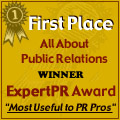|
by
Marsha Friedman
EMSI
 One
of the most common dilemmas I encounter with many clients is the
preconceived notions of what it takes to make sales. The problem
with these preconceived notions is that they often misdirect
people into thinking there is empirical evidence that lays out
the sales cycle in absolutes. But, that just doesn’t exist. One
of the most common dilemmas I encounter with many clients is the
preconceived notions of what it takes to make sales. The problem
with these preconceived notions is that they often misdirect
people into thinking there is empirical evidence that lays out
the sales cycle in absolutes. But, that just doesn’t exist.
So, what IS real? Exposure is a real tangible element in a
marketing and sales cycle, because without it, you can’t sell a
thing. Just as a candle under a bucket yields no light, a
product or service that no one knows about will yield no sales.
People have to know about you to do business with you.
Whether you are selling a book, a product or a service –
exposure is the first and primary goal of marketing. While
exposure doesn’t guarantee sales, any hope of generating sales
can only result from getting in front of your potential
consumer. But, when your product receives that coveted exposure
to the masses, the X-factors in play become whether or not
consumers will like what they see. Your product will either be
exactly what the consumer is looking for, or it won’t.
I was talking to my senior strategist and he reminded me of the
launch of New Coke back in the 1980s. Coca-Cola decided that
Pepsi’s gains in the marketplace meant that consumers wanted a
sweeter-tasting soda pop than Coke’s patented formula delivered.
So, they scrapped their mainline product altogether and
introduced New Coke with a multi-million dollar ad campaign
featuring prime time darling Bill Cosby.
Their new product launch tanked. Consumers wanted their old Coke
back. The moral of the story is that everyone in America had
been exposed to New Coke. But, it also appeared that no one in
America wanted to buy it. That’s the flip side of exposure,
because great marketing doesn’t make something a quality
product, nor can it fool people into wanting something they
wouldn’t ordinarily buy. Your product must be able to stand on
its own once it receives the exposure.
In the absence of empirical data, let’s take a look at some
anecdotal data – specifically, your own. Ask yourself some
simple questions. When was the last time you made a purchase of
anything after being exposed to it only once? When was the last
time an advertisement or an article about a product or service
made SUCH an impression on you that you immediately made
arrangements to buy it? If you’re like most consumers and
business decision-makers, the answer to that question is either
never, or rarely. The first step was that you were made aware of
it, and perhaps after several exposures to that item, you then
became interested in it.
Interest is what comes as a result of exposure, but interest
doesn’t necessarily get you reaching for your check book.
Interest usually spurs you to get information. You research it
online, you ask friends about it, you ask business associates to
weigh in on it – you collect your OWN data. And if you still
want more information, you may decide to contact the company and
ask them about it. My point here is that there are hundreds of
ways to act on interest that does not involve making a purchase,
and each of those actions represents a series of decision
points, at which you may still decide not to buy.
Short of climbing inside our heads, which some researchers are
doing these days under the category of “behavioral research” to
track how consumers make buying decisions, there is no ironclad
way to track what happens with the consumer from the point of
exposure to the point of sale. In the advertising world, you’ll
find a wide range of references about the frequency of
advertising required to CAUSE a sale. But, my problem with those
theories is they don’t take into account what actions the buyer
took during the “interest” phase of their buying process that
really caused the decision to buy.
And that is my point, and it’s why I know the value of PR and
it’s how I’ve been able to sustain and grow a thriving PR agency
over the course of 20+ years, through recessions and economic
downturns and absolute market upheaval. It’s because of this one
truth: You can’t sell anything without exposure that creates
interest in the minds of the consumer. And PR is the most
cost-effective and successful way of achieving that exposure and
interest.
So, while good marketing and PR may not make record-breaking
sales a mortal lock, you will never even be in the game without
it.
Marsha Friedman, CEO of
EMSI
Public Relations, is a 20-year
veteran of the public relations industry, who provides PR
strategy and publicity services to corporations, entertainers,
authors and professional firms.
She is also the author of the book, Celebritize Yourself.
marsha@marshafriedman.com
More Articles |
Submit Your Article |
PR Subjects
About Public Relations Homepage
Contact Us
|



